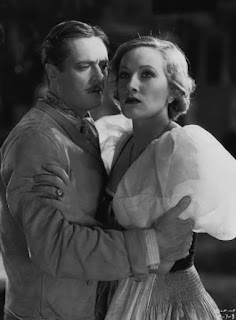"I'll run the farm myself....A farm can't have two masters"
Joanna Godden ( Googie Withers ) is a determined woman. After the death of her father, the townsfolk of Romney Marsh assumed that she would marry her childhood friend and neighbor-farmer Arthur ( John McCallum ), joining her father's farm with his to make it one of the largest in the county. Instead, she boldly declares that she does not wish to marry Arthur and, defying the conventions of the time, wants to run the farm by herself. Her farmhands are none too pleased with the notion of a single woman taking charge of the farm and Arthur is certainly disappointed to hear that she does not wish to marry him. If this wasn't news enough, she announces that she will take her father's pedigree sheep and crossbreed them. "She's a filly that's never been properly broke in, that's what she is!" the farmers exclaim.
The Loves of Joanna Godden may seem like just another British film about farming and shepherding but it is much more than that. It is the profile of a headstrong young Edwardian woman and the decisions - mainly regrettable ones - that she makes within a several-year span that leads to her growth as a woman. Joanna does indeed take control of the farm as she wanted, but she stubbornly refuses to listen to the admonitions of her neighbor farmers who warn her against crossbreeding sheep and soon regrets not heeding their warning. The new breed of sheep has a coat much too thin to brave the cold wind that blows on the marsh and many of them die. When she does choose to marry a man ( Derek Bond ) that turns out tragic as well.
Director Charles Frend does an admirable job of creating a unique Edwardian English-country atmosphere for The Loves of Joanna Godden. The only other film that comes close to capturing this setting is 20th Century Fox's The Ghost and Mrs. Muir, which was released the same year. Both films are similarly themed and focus on a two-year period in the life of a strong-willed Edwardian woman. Widow Mrs. Muir ( Gene Tierney ) wishes to be independent of her in-laws and make her own life in the seaside town of Whitecliff-by-the-sea.In The Loves of Joanna Godden, Joanna is content to stay at her childhood home but wants the freedom to run it as she pleases without taking orders from a man. Eventually, both characters regret not having a husband to "take the helm". If these films were made today, their directors would probably take a more feminist approach and show audiences that a woman can be independent and happy as well, but these old classics reflected Edwardian sentiments and personally, I like that.
H.E. Bates' screenplay condenses Sheila Kaye-Smith's 1921 novel into a concise 90-minute film without losing any of the major plot points or its biting dialogue. The Loves of Joanna Godden also features a sweeping score by Ralph Vaughn Williams and beautiful cinematography. Oscar-nominated cinematographer Douglas Slocombe ( Dead of Night, The Great Gatsby ) is often considered to be one of the best in the industry. Through his lens, we get to travel to Kent and see the beauty of Romney Marsh throughout the seasons.
Googie Withers gives a wonderful performance as the headstrong Joanna. She's a stubborn character and she could easily have been a dislikable woman but Googie lets the audience know that beneath Joanna's hard exterior is a soft and vulnerable woman. Arthur knows this already and that makes it painful for him to stand by and witness Joanna shun all help in her attempt to stand on her own feet when he would willingly work beside her.
John McCallum was a popular and extremely capable actor who made many British films in the 1940s. He and Googie wed shortly after filming was completed on this picture. McCallum later turned to producing ( the Australian children's series Skippy was one of his productions ) and Googie went on to have a long career on stage and television, notably as Governess Fay Boswell in Within These Walls.Jean Kent, another popular leading lady in British films, has a supporting role as Joanna's sister Ellen. At first, Ellen is quite a charming young lady but she quickly becomes a conniving and spoiled brat and the cause of ruination for Arthur. Derek Bond gives a good performance as the young aristocrat Martin who sweeps Joanna off her feet, and Australian legend Chips Raffery has a small part as Joanna's looker ( shepherd ). Also in the cast are character actors Henry Mollison and Edward Rigby.
The Loves of Joanna Godden is available on DVD as one of four films on Network's "Ealing Studios Rarities Collection, Volume 4".This post is our contribution to the 8th Annual Rule, Britannia blogathon being hosted by A Shroud of Thoughts. This is a jolly good event that allows bloggers to review British films from all eras, so if you want to explore some new-to-you titles, be sure to head on over to the event for a full listing of entries.















